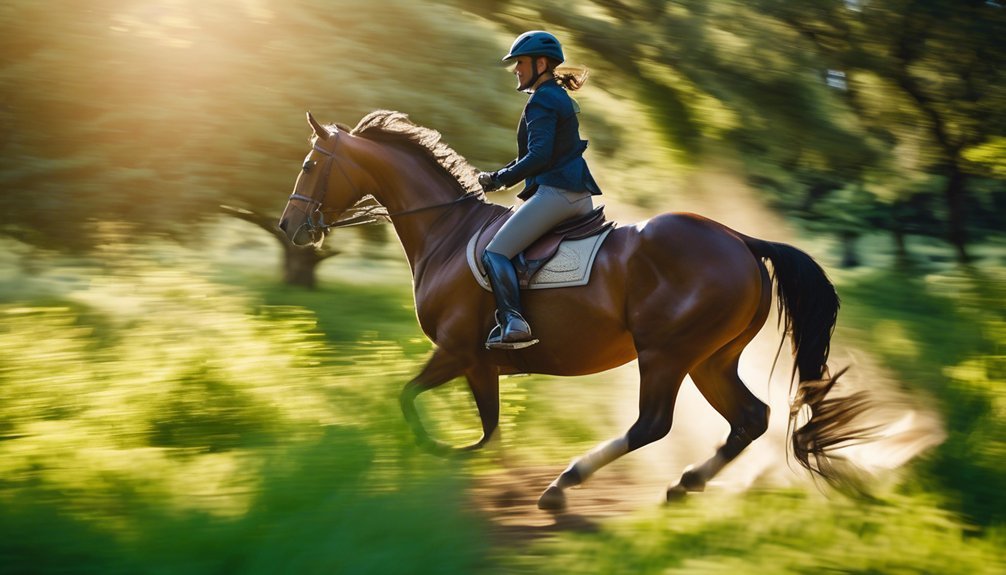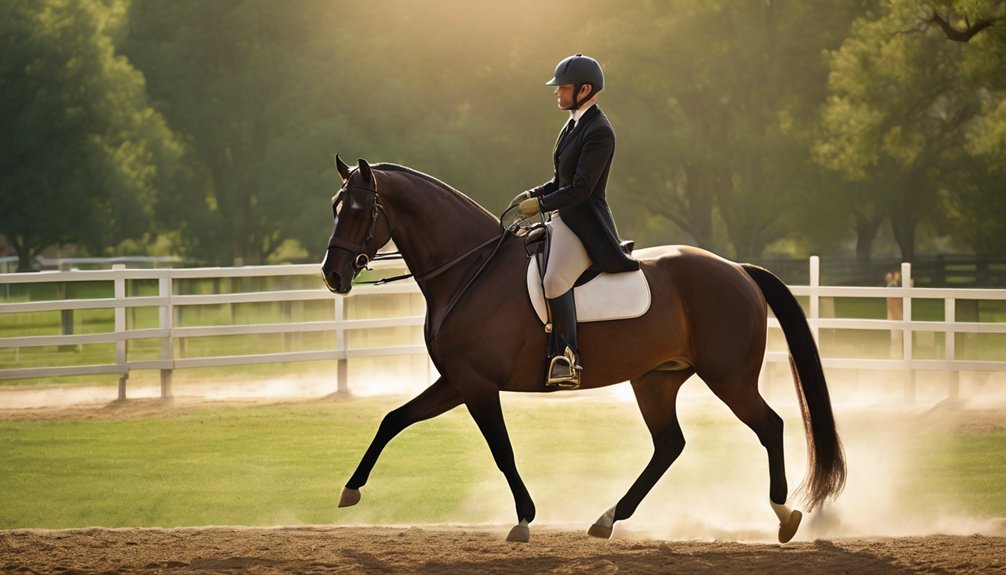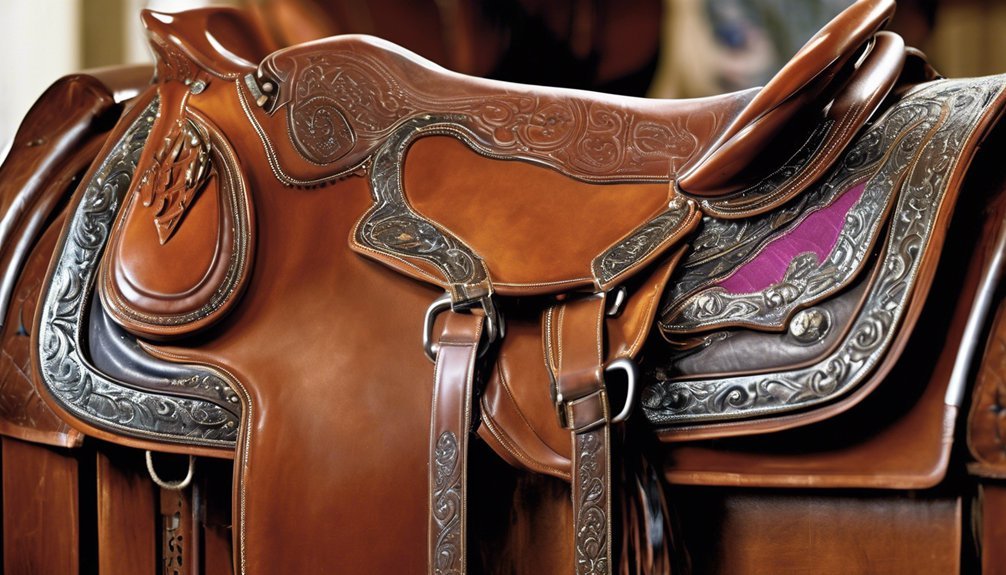
In equestrian sports, your fitness level plays a pivotal role in your performance and safety. A strong core helps you maintain stability, while cardiovascular endurance allows you to ride longer with ease. Moreover, mental focus can be the difference between success and setbacks in competitions. Understanding how to enhance your physical abilities can transform your riding experience and strengthen your bond with your horse. What specific areas of fitness should you prioritize to achieve your goals?
Key Takeaways
- Rider fitness enhances core strength, stability, and balance, directly influencing performance and connection with the horse.
- Improved cardiovascular endurance allows riders to maintain stamina during long rides, boosting overall physical capabilities.
- Mental focus and resilience are crucial for competitive success, helping riders manage stress and concentrate effectively.
- A fit rider promotes better communication and trust with their horse, resulting in improved responsiveness and smoother transitions during riding.
- Commitment to fitness fosters a sense of belonging in the equestrian community, encouraging shared goals and camaraderie among riders.
Understanding the Physical Demands of Equestrian Sports

When you step into the saddle, you're not just riding a horse; you're engaging in a sport that demands a unique blend of strength, flexibility, and endurance.
To excel, you need to understand equine biomechanics and how your rider posture directly influences your performance. Your posture affects the horse's movement, balance, and responsiveness, so staying aware of how you sit and shift your weight is crucial.
Engaging your core and maintaining proper alignment not only enhances your control but also strengthens the connection with your horse.
As you embrace these physical demands, you'll find that each ride becomes a journey of self-discovery and camaraderie within the equestrian community. Your growth as a rider is an integral part of this shared passion.
Core Strength: The Foundation of Rider Stability
Core strength serves as the cornerstone of rider stability, playing a pivotal role in your overall performance in the saddle.
When you enhance your core stability, you'll notice a significant improvement in your rider posture, allowing you to sit deeper and more balanced. This stability not only helps you maintain your position, but it also enables you to communicate more effectively with your horse.
You'll find that a strong core reduces the risk of fatigue during long rides, keeping you energized and focused. Moreover, it fosters a deep sense of connection with your mount, making each ride feel more harmonious.
Invest time in core-strengthening exercises, and you'll unlock your true potential as a rider, feeling more confident and capable every time you ride.
Flexibility and Balance for Optimal Performance
While many riders focus on strength training, flexibility and balance are equally crucial for optimal performance in the saddle.
To enhance your riding, incorporate dynamic stretching into your routine, as it prepares your muscles for movement and increases your range of motion. This will allow you to respond effectively to your horse's movements, creating a harmonious partnership.
Proprioceptive training is also essential; it sharpens your body awareness, helping you maintain balance and stability during various gaits.
By prioritizing these elements, you not only improve your performance but also deepen your connection with your horse.
Embrace flexibility and balance, and you'll elevate your riding experience while fostering a sense of belonging within the equestrian community.
Cardiovascular Endurance: Riding for Hours

As you prepare for long rides, building cardiovascular endurance becomes essential for maintaining stamina and focus in the saddle. Engaging in endurance training not only enhances your physical capabilities but also fosters a deeper connection with your horse.
Incorporate activities like running, cycling, or swimming into your routine to boost your stamina building. These exercises improve your heart rate and breathing efficiency, allowing you to ride for hours without fatigue.
Remember, the more conditioned you are, the better you can respond to your horse's needs and movements. By committing to your fitness, you're not just improving your performance; you're also becoming part of a community that values dedication and resilience in the equestrian world.
Embrace the journey!
Mental Focus and Resilience in Competition
Riding for hours can build your physical stamina, but mental focus and resilience are equally vital when it comes to competition. Developing mental clarity and a competitive mindset can help you tackle performance anxiety. Use focus techniques and visualization techniques to prepare yourself mentally, ensuring you're ready to perform at your best.
| Challenge | Technique | Outcome |
|---|---|---|
| Performance Anxiety | Stress Management | Increased Confidence |
| Distractions | Focus Techniques | Enhanced Concentration |
| Emotional Setbacks | Emotional Resilience | Strengthened Resolve |
With consistent mental conditioning, you'll cultivate resilience to overcome obstacles, fostering a sense of belonging within the equestrian community. Embrace this journey and elevate your performance!
Injury Prevention Through Proper Conditioning
To prevent injuries in equestrian sports, proper conditioning is essential for every rider. By focusing on effective conditioning techniques, you can significantly reduce the risk of common injury types, such as strains, sprains, and overuse injuries.
Engaging in strength training, flexibility exercises, and cardiovascular workouts helps build the necessary endurance and stability for riding. Consider incorporating Pilates or yoga to enhance your core strength, which supports balance and posture in the saddle.
Additionally, prioritizing recovery through rest and nutrition fosters resilience, allowing your body to adapt to the physical demands of riding. When you commit to a structured conditioning plan, you not only protect yourself from injuries but also build confidence and camaraderie within the equestrian community.
Tailoring a Fitness Regimen for Equestrian Needs

While equestrian sports demand a unique blend of physical and mental skills, tailoring a fitness regimen specifically for your needs can enhance performance and enjoyment in the saddle.
Start with fitness assessments to identify your strengths and weaknesses, aligning your regimen with your equestrian goals. Incorporate strength training to build core stability, essential for effective riding drills.
Balance this with endurance activities to improve stamina during long sessions. Don't forget flexibility exercises to maintain agility and prevent injuries; injury awareness is key.
Create personalized plans that adapt as you progress, and use performance tracking to monitor improvements.
Lastly, employ motivation techniques to keep your spirits high, fostering a sense of community and belonging within the equestrian world.
The Role of Nutrition in Rider Performance
Nutrition plays a crucial role in enhancing rider performance, as the right fuel can significantly impact your energy levels, focus, and overall resilience in the saddle. Implementing effective nutrition strategies is essential for sustaining your stamina during long rides and competitions.
Prioritize whole foods, rich in carbohydrates, proteins, and healthy fats, to support muscle recovery and endurance. Don't overlook hydration techniques, either; staying properly hydrated boosts concentration and prevents fatigue.
Consider electrolyte-rich drinks before and after strenuous activities to maintain optimal performance. Remember, fueling your body isn't just about quantity—quality matters too.
Cross-Training: Benefits Beyond the Saddle
Cross-training can elevate your equestrian performance by enhancing your overall fitness, agility, and strength. Incorporating strength training into your routine builds the muscle necessary for effective riding.
A regular yoga practice enhances flexibility and balance, while Pilates benefits core stability, essential for maintaining posture in the saddle. Engaging in endurance workouts boosts your stamina, allowing you to ride longer without fatigue.
Agility drills sharpen your quick reflexes, and coordination exercises improve your connection with your horse. Don't forget sport-specific activities that mimic riding movements, reinforcing muscle memory.
Lastly, utilizing recovery techniques ensures you're ready for each ride. By embracing cross-training, you're not just improving your performance; you're fostering a sense of community among fellow riders who share your passion for excellence.
The Synergy Between Rider and Horse Fitness
Improving your fitness as a rider directly influences your horse's performance, creating a powerful synergy between both of you. When you're fit, you can maintain better balance, coordination, and control, allowing your horse to respond more effectively. This horse rider synergy enhances communication, fostering trust and confidence in your partnership.
Fitness integration isn't just about your physical strength; it's about your mental resilience too. As you train, you develop a deeper understanding of your horse's needs and capabilities.
Together, you can tackle challenges with a united front. So, invest in your fitness, and you'll notice how it transforms not just your riding, but your entire relationship with your horse. Embrace this journey together, and watch your potential soar.
Frequently Asked Questions
How Does Rider Fitness Impact Horse Performance?
Rider fitness significantly impacts horse performance; your endurance and core stability enhance balance and communication. When you're fit, your horse responds better, creating a stronger partnership. Invest in yourself, and watch your horse thrive together.
What Are Common Fitness Misconceptions Among Riders?
Many riders think they only need strength training for success, but neglecting rider nutrition can hinder performance. Balancing both elements is crucial; you'll find that proper fuel enhances your strength and overall riding effectiveness.
Can Yoga Improve My Riding Skills?
Absolutely, yoga can skyrocket your riding skills! It enhances flexibility training, improves balance, and strengthens core muscles. Embracing yoga benefits not only elevates your performance but also fosters a deeper connection with your horse.
How Often Should Riders Cross-Train?
To maximize cross training benefits, you should incorporate it into your training schedules at least two to three times a week. This variety strengthens your body, enhances your skills, and fosters a supportive riding community.
What Fitness Assessments Should Riders Consider?
You should consider fitness benchmarks like strength, flexibility, and endurance for your rider assessments. Regularly evaluating these areas helps you identify strengths and weaknesses, ensuring you stay competitive and connected within your equestrian community.
Conclusion
In equestrian sports, your fitness isn't just a personal asset; it's a game-changer for you and your horse. Studies show that riders with strong core strength can improve their performance by up to 20%. By prioritizing your physical health—through strength training, flexibility exercises, and proper nutrition—you enhance your riding skills and deepen your bond with your horse. Embrace this journey; your commitment to fitness can lead to greater success in the saddle and a more fulfilling equestrian experience.





